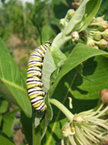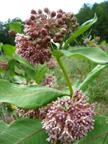Global warming may reroute evolution
19 Feb 2011
Rising carbon dioxide levels associated with global warming may affect interactions between plants and the insects that eat them, altering the course of plant evolution, research at the University of Michigan suggests.
The research focused on the effects of elevated carbon dioxide on common milkweed, Asclepias syriaca. Milkweed is one of many plants that produce toxic or bitter chemical compounds to protect themselves from being eaten by insects. These chemical defenses are the result of a long history of interactions between the plants and insects such as monarch caterpillars that feed on them.
 Plant defenses - and insect eating patterns - also respond to environmental factors such as rising carbon dioxide. This suggests that elevated carbon dioxide could affect plant evolution by altering the "selection pressure" that plant-eating insects exert on plants.
Plant defenses - and insect eating patterns - also respond to environmental factors such as rising carbon dioxide. This suggests that elevated carbon dioxide could affect plant evolution by altering the "selection pressure" that plant-eating insects exert on plants.
Selection pressure, the driving force of evolution, induces changes in the genetic composition of a population. It works like this: if insects inflict too much damage on plants, the plants can't reproduce as successfully. This sets up a situation in which any plants that, by chance, have inherited insect-deterring traits are at an advantage. Because of that advantage, such traits are likely to spread through the population, urged on by "pressure" from the insects.
Researchers Rachel Vannette and Mark Hunter investigated whether different genetic "families" of the common milkweed from a single population in Northern Michigan would respond differently to increasing carbon dioxide levels in the atmosphere and if so, how those responses might affect the plants' chances of being eaten by insects.
 "Specifically, we examined the response of milkweed plants to elevated carbon dioxide in terms of plant growth, asexual reproduction, and the production of chemical and physical defenses," Vannette said. Although all plants grew larger in response to elevated carbon dioxide, and all plant families showed similar growth and reproductive responses, plant families responded differently to elevated carbon dioxide in their production of chemical and physical defenses against plant-eating insects.
"Specifically, we examined the response of milkweed plants to elevated carbon dioxide in terms of plant growth, asexual reproduction, and the production of chemical and physical defenses," Vannette said. Although all plants grew larger in response to elevated carbon dioxide, and all plant families showed similar growth and reproductive responses, plant families responded differently to elevated carbon dioxide in their production of chemical and physical defenses against plant-eating insects.






























